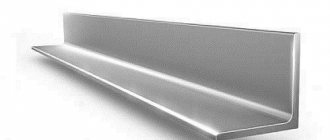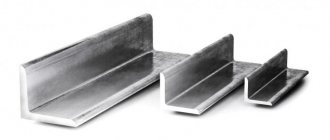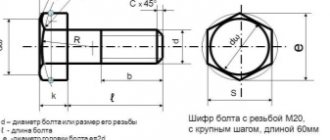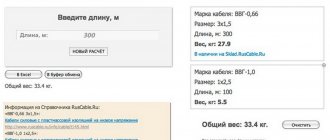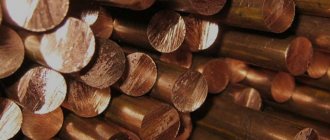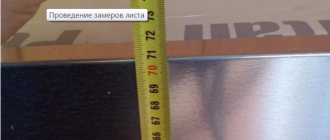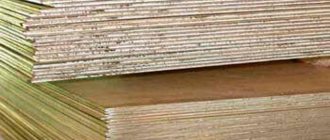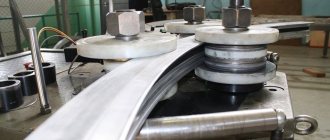Characteristics and production principle
Today, equal-flange steel angles are manufactured in accordance with legislative standards, which are prescribed in the documentation GOST 8509–93. For mass production of this category of rolled metal, universal square-shaped blanks are used, which ultimately acquire the desired shape with shelves of equal width. Among specialists, such details vary depending on accuracy indicators (the number of deviations from the established norm). Due to this, there are two most common classifications of corners:
- Products of ordinary precision are marked with the letter “B”.
- High precision parts - designated as “A”.
In industrial construction, conventional precision products are most often used. But if the corner will be used in the manufacture of critical metal structures that will be systematically subjected to heavy loads, then it is best to use high-precision parts. This is due to the fact that such products have higher strength indicators.
As for class “B” corners, permissible deviations from the established standards apply to them:
- A steel corner whose shelf width reaches 90 mm must have a permissible deviation of 1.5 mm.
- If the shelf width is 45 mm, then the permissible deviation should not exceed 1 mm.
- The permissible deviation in corners up to 250 mm should not exceed 3 mm.
- When the shelf width is 150 mm, the deviation level is within 2 mm.
It is also worth considering that experts distinguish between several types of equal-flange steel angles, which differ in thickness. Indicators from 0.3 to 0.5 mm are considered normal.
As for the production process, it is divided into two main stages. The hot-rolled manufacturing method is based on the fact that a steel billet is passed through special rotating shafts. Thanks to this, the required dimensions of the product are formed. Only after this the billets are passed through a rolling mill under high pressure.
It is important to note that twisting the product along the axis is considered simply unacceptable. The final curvature of the part should be within 0.4% of the entire length.
What is stronger: a corner or a profile pipe: we delve into the nuances
As in the topic of contrasting a similar pipe with a channel, which we described separately, 2 specific products should be compared, and not both categories as a whole.
The strength of the product depends on the parameters:
- chemical composition of the metal used in production;
- manufacturing method (it was mentioned above that a hot-rolled angle is stronger than a cold-drawn one);
- geometric parameters of the product in question - length, thickness, width;
- weight;
- the presence of a weld (if we are talking about pipes);
- additional surface treatment (galvanization strengthens the product, preventing corrosion from destroying the metal in the long term).
Modern classification
Today there are several main classifications of steel angles. Their differences lie in the scope of application:
- Unequal. This type of rolled metal is widely used for the construction of complex structures such as arches.
- Equal. Most often used in the construction industry, as well as for the production of furniture and various openings. This is especially true for situations where you need to get a perfectly even angle.
- Galvanized. Widely used in environments with aggressive environments and chemical exposure.
- Hot rolled. It is considered the most popular among similar products, as it can be used for the manufacture of critical units of load-bearing structures, where high tension in the material is predicted.
- Corner made of stainless material. Craftsmen widely value this type of rolled metal, as it can be used for rooms with high levels of humidity.
- Products made from low alloy steel. Such parts are used in cases where the structure is subject to heavy loads and negative atmospheric factors.
- Bent corner. The wide range of applications of this rolled metal is due to the fact that it is characterized by a simple installation scheme and low weight. But it is important to take into account the disadvantage of such products - low strength indicators, which prevents their use in certain structures.
Calculation of pipe beams for bending
Our website provides a calculator for determining the bending of pipe beams. The bending calculation logic allows you to obtain the most accurate values. Before calculating the bend, we strongly recommend that you read the instructions for online calculators to determine the bend.
Online calculator
The purpose of the calculator to determine the bend
Wood is the most widely used material for creating frames for various buildings. From it, like from plasticine, you can create a design of any complexity. However, not the last place is occupied by such structural material as various metal profiles. They are distinguished by such properties as plasticity, durability and strength. Not the last place among such materials is occupied by profile and round pipes. Try to imagine a carport made from a profile pipe coated with polycarbonate and the same structure from a corner.
It seems there can be no two opinions. And any beam in the structure must be calculated. This is necessary for two reasons:
- Obtain an object with a sufficient margin of safety under the influence of its own weight, as well as wind and snow loads.
- Select the minimum profile acceptable for the building in order to minimize the cost of materials.
To achieve this goal, you need to use our online calculator and calculate the bending of a pipe beam. This is the case if the part is fixed on one side (cantilever). If both ends are fixed, you will need to calculate the beam for deflection.
Optimal weight and length
Many experts prefer to use a 50x50x5 corner. The weight of 1 meter according to GOST is 3.77 kg. It is worth noting that the weight of such a workpiece can be determined in several ways. But the fastest and easiest option is when the master uses a special table for the assortment of equal-flange steel products from the relevant GOST standards. Thanks to this, you can find out the theoretical specific gravity indicators for each standard size.
In addition to the weight of the 50x50x5 corner, it will be useful to know some more nuances that must be indicated when ordering suitable transport for transportation. Thus, the final product can be of a measured length with values of 6, 9 and even 12 meters. But unmeasured corners vary in length from 4 to 12 meters.
You should always take into account that if this category of rolled metal will be used in difficult operating and weather conditions, then it is best to choose angles made of low-alloy steel. In this case, the following brands are in greatest demand: 09G2, 10HSND, 12GS, 09G2S or 17G1S.
Despite the fact that the length of measured products varies from 4 to 12 meters, each batch may contain an angular profile of unmeasured length (no more than 5% of the total mass). With unmeasured products, everything is completely different; their sizes cannot be less than three meters and more than twelve. In the case of an individual order, rolled metal can be produced in a limited, unmeasured length. If the work requires an angle of 6 meters or more, then the resulting deviations should not exceed 70 mm.
For certain construction work, the curvature of the corners is of great importance. In the case of high-precision products, this figure should not exceed 0.2%, but for ordinary accuracy - 0.4%.
It is worth considering that if the corner will be used in an industry where strength and anti-corrosion properties are of great importance, then it is best to choose those products that are made of steel 15 HSND and 10 HSND. After all, it is precisely this type of rolled metal that will have sufficient lightness and a long service life.
Beam calculator - calculation for different types of structures
Beams in a house usually belong to the rafter system or floor, and in order to get a reliable structure that can be operated without any fear, you need to use a beam calculator .
What is the beam calculator based on?
When the walls have already been brought under the second floor or under the roof, it is necessary to make a ceiling, in the second case smoothly turning into rafters. In this case, the materials must be selected so that the load on the brick or log walls does not exceed the permissible value, and the strength of the structure is at the proper level. Therefore, if you are going to use wood, you need to choose the right beams from it and make calculations to determine the required thickness and sufficient length.
Beam calculator
The subsidence or partial destruction of the ceiling can be due to various reasons, for example, too large a step between the lags, deflection of the cross members, too small their cross-sectional area or defects in the structure. To eliminate possible excesses, you should find out the expected load on the floor, be it basement or interfloor, and then use a beam calculator, taking into account their own weight. The latter can change in concrete lintels, the weight of which depends on the density of the reinforcement; for wood and metal, with a certain geometry, the weight is constant. The exception is damp wood, which is not used in construction work without first drying it.
Beam systems in floors and rafter structures are loaded by forces acting on section bending, torsion, and lengthwise deflection . For rafters, it is also necessary to provide for snow and wind loads, which also create certain forces applied to the beams. You also need to accurately determine the required step between the jumpers, since too many crossbars will lead to excess weight of the floor (or roof), and too little, as mentioned above, will weaken the structure.
How to calculate the load on a floor beam
The distance between the walls is called a span, and there are two of them in the room, and one span will necessarily be smaller than the other if the shape of the room is not square. Interfloor or attic floor lintels should be laid along a shorter span, the optimal length of which is from 3 to 4 meters. Larger spacing may require non-standard sized beams, which will result in some unsteadiness of the deck. The best solution in this case would be to use metal crossbars.
Regarding the cross-section of a wooden beam, there is a certain standard that requires that the sides of the beam have a ratio of 7:5, that is, the height is divided into 7 parts, and 5 of them must make up the width of the profile. In this case, deformation of the section is excluded, but if you deviate from the above indicators, then if the width exceeds the height, you will get a deflection, or, if the opposite discrepancy occurs, a bend to the side. To prevent this from happening due to the excessive length of the beam, you need to know how to calculate the load on the beam. In particular, the permissible deflection is calculated from the ratio to the length of the lintel as 1:200, that is, it should be 2 centimeters per 4 meters.
To prevent the beam from sagging under the weight of logs and flooring, as well as interior items, you can grind it from below a few centimeters, giving it the shape of an arch; in this case, its height should have an appropriate margin.
Now let's turn to the formulas. The same deflection mentioned earlier is calculated as follows: fnor = L/200, where L is the span length, and 200 is the permissible distance in centimeters for each unit of beam subsidence. For a reinforced concrete beam, the distributed load q on which is usually equal to 400 kg/m 2, the calculation of the maximum bending moment is performed using the formula Mmax = (q · L 2)/8. In this case, the amount of reinforcement and its weight is determined according to the following table:
Cross-sectional areas and mass of reinforcing bars
Beam calculator - calculation for different types of structures
Security in the house is not only video surveillance, but also strong walls and ceilings, which means that during construction it’s a good idea to use a beam calculator
Areas of application
Today, there are many different areas where 50x50x5 angle steel is successfully used. The weight of 1 meter of corner is considered optimal for implementing various construction and engineering tasks. Professional builders and designers consider this material indispensable, since it can be used to create durable metal frames and concrete structures, build durable bridges, overpasses, pavilions, canopies, stopping points and canopies.
The corner has found particularly wide application in architecture, as well as in the decoration of buildings and other objects: benches, gazebos, doors, fences, gates, fences and even stairs. You can often find angle steel in the furniture industry, as it is used to make durable frames, steel trims and other elements.
Metal corners are widely used in the automotive and carriage building, as well as in the production of large-sized equipment. Craftsmen use such details to harmoniously design corners when creating door and window openings, and also as an original decorative element for various structures.
The main differences between aluminum products
Aluminum corners with different thicknesses differ from each other in the same way as steel ones. Determining the exact weight of such products is quite simple. Initially, the master needs to find out the specific gravity of 1 meter, which is then multiplied by the total number of meters in the batch. If the work is carried out using metal products that are manufactured in accordance with the standards of GOST 13737, then all calculations can be significantly simplified. The main thing is to have the appropriate regulatory document.
It is always important to remember that the weight of one meter of aluminum corner 50x50x5 is only 1,210 kg. In addition, such products have many operational advantages:
- It lends itself well to any type of processing.
- It is not subject to the negative effects of corrosion, which ensures the longest service life.
- Operates in any temperature conditions.
- It is possible to recycle with the least financial investment.
- Despite the light weight of aluminum products, they are highly durable and can withstand heavy loads.
- The good plasticity of the material simplifies installation work.
Experts note that aluminum corners are distinguished by their versatility and reliability. This is due to the fact that with their help you can build any structure that will have high strength characteristics without significantly affecting the weight of the finished structure.
What is stronger: corner or profile pipe?
Good afternoon, dear forum users! I plan to make a rack with spans of 2.5 meters, shelf width 700 mm. 20 mm plywood will be laid in the interior space. the lintels under the plywood will be made of professional pipe 20x40 mm. The load will be approximately 100-150 kg per shelf. what material is better to use, a 60x40 profile pipe with a wall thickness of 2 mm, or a 50x50 corner with a shelf thickness of 5 mm. I plan to hold concrete fence sections and 500x500 mm concrete slabs with a thickness of 50 mm on the racks. As you understand, deformation is unacceptable. What do respected gurus advise?
Best regards, Arman!
At one time they made something similar, shelving for sanitary ware. The pots and shelves are still standing. The structure was made from a 50x50 mm corner. [
Answer to the question: The best option to choose fence posts is made of tubing pipes (thick-walled pipe 5-8mm, seamless, durable - more than 50 years, 73 comes with a wall of 5.5 mm; this pipe will rot forever; the grade of steel is very cold/ the corrosion-resistant steel grade itself is NKT 20, steel NKT 30, steel NKT 30 KhMA and it costs 210 rubles/meter.).
Which post should be preferred when constructing corrugated fences? The vast majority of people will say that a metal pipe is the best option. This is true. A pipe made of steel has the necessary strength to withstand bending loads, is durable and economical.
What cross-section should this pipe have: round or square? About half of people lean toward the first option, while the other half choose the second option. Aesthetic nuances aside, let’s consider what properties distinguish a square pipe from a round pipe.
Definitely, the bending strength of a square pipe will be much greater. If we take two pipes (square and round) with the same parameters, then the moment of resistance of the square pipe in cross-section will be approximately 1.7 times greater than that of the round pipe. This indicator is typical for square pipes, which are located parallel to the fence plane (that is, in 99% of cases). If the pillars are installed at an angle to the fence structure, the moment of resistance of a square pipe will exceed that of a round pipe by only 1.2 times.
But the technology, when the pipe is installed to the fence plane at a certain angle, has one significant drawback. In places where the logs are welded to the pole, corrosion will certainly form, which is almost impossible to combat. This is facilitated by constant humidity (due to precipitation), a sufficient amount of oxygen and lack of ventilation. Such conditions greatly accelerate corrosion processes, and the metal is destroyed very quickly. The weld also plays an important role in the development of corrosion. Only a few years will pass and the welded joint will completely fail. As a result, the fence will need repair or even replacement. Moreover, these destructions cannot be prevented or slowed down, since corrosion processes develop from the inside of the pipe.
People think that they can cut the fence logs in multiples of the post spacing, and then weld them end-to-end to each of the posts. But this, firstly, is not rational, since it requires a lot of work and considerable expenses. And, secondly, the strength and rigidity of the structure in the plane of the fence is significantly reduced. In this situation, the main load of the structure acts on the welds, which, according to engineers, is fundamentally wrong. In winter, under the influence of frost heaving forces, some of the pillars may rise. As a result, the welded joints cannot cope with the load and collapse. In addition, this requires high-quality welding work to ensure the tightness of the weld, in order to subsequently eliminate corrosion in the internal part of the log pipe.
A lot of people think that corrugated steel for a fence makes the structure of the fence more rigid, but this is far from the case. When the fence warps, the corrugated sheet simply breaks at the joints.
Certification and implementation
The quality of manufactured equal-flange steel angles is controlled by GOST standard indicators. The main confirmation of the reliability and durability of corner metal products is a certificate, which is issued to manufacturers for a maximum of 3 years. When this period expires, the manufacturing company must go through all stages of certification again in a special Center. The manufacturer receives copies of the technical specifications for the manufacture of angles. Thanks to this, such a design always has high strength indicators that do not depend on operating conditions.
Most often, manufacturers sell whole batches of such parts, the weight of which does not exceed 70 tons. In addition, the products must be marked accordingly. Depending on the size, all products are packaged in special packs, which are also marked. Due to this, the transportation and unloading of products is greatly facilitated.
Separately, it is worth considering that in some cases the herringbone laying system - groove in groove - can be used. This technology is considered the most practical in the field of industrial construction.
Characteristic advantages
It is in the construction industry that metal corners are most often used, since the price of these products is considered affordable, thanks to which large quantities of rolled metal can be purchased. The products themselves are presented in the form of a solid profile without any hollow spaces. Thanks to this, it is possible to achieve high performance and strength indicators, which is very important in the field of industrial and construction organizations. Most often, 50x50x5 corners are made of low-alloy and carbon steel, which determines such a high level of reliability of the metal corner.
It is also worth considering that the main advantages of steel angles include the following indicators:
- Good resistance to any deformation.
- Resistant to the negative effects of corrosion.
- Increased strength indicators.
- Resistant to sudden temperature changes.
- Possibility of reliable connection using a welding machine.
Before purchasing a metal corner, you need to carefully familiarize yourself with the technology of its production, which involves two universal methods. The first technology is based on rolling, when a metal billet passes through a multifunctional mill so that the steel angle acquires the desired shape and size. As for bent products, the bending technology itself involves the use of universal roll forming mills. It is worth considering that it is most suitable for thin-walled corners that cannot be used to reinforce floors.
Square pillars still have a number of disadvantages
- the design turns out to be very labor-intensive, since it is necessary not only to ensure the vertical position of the pillars, but also to ensure that one of their faces is in the plane of the fence;
- since the weight of a square pipe is 30% more than a round one, its cost is 35% more expensive;
- the weld seam, present in pipes with a square cross-section along their entire length, serves as a place for the active development of corrosion processes, which are not hindered even by painting.
Therefore, we recommend that for fence posts you choose posts from used tubing pipes with a round cross-section and with the greatest possible wall thickness. It would be great if these pipes were made using seamless technology.
The joists are attached to the round posts in an overlapping manner using two short seams along the top and bottom edges of the joists. Such connections are not blown out, last a long time, and can be protected from corrosion with paint. The weld in this case is very strong, and the load-bearing structure of the fence has maximum rigidity due to the fact that the logs do not have to be cut. In addition, individual pillars do not protrude from the ground in this case.
